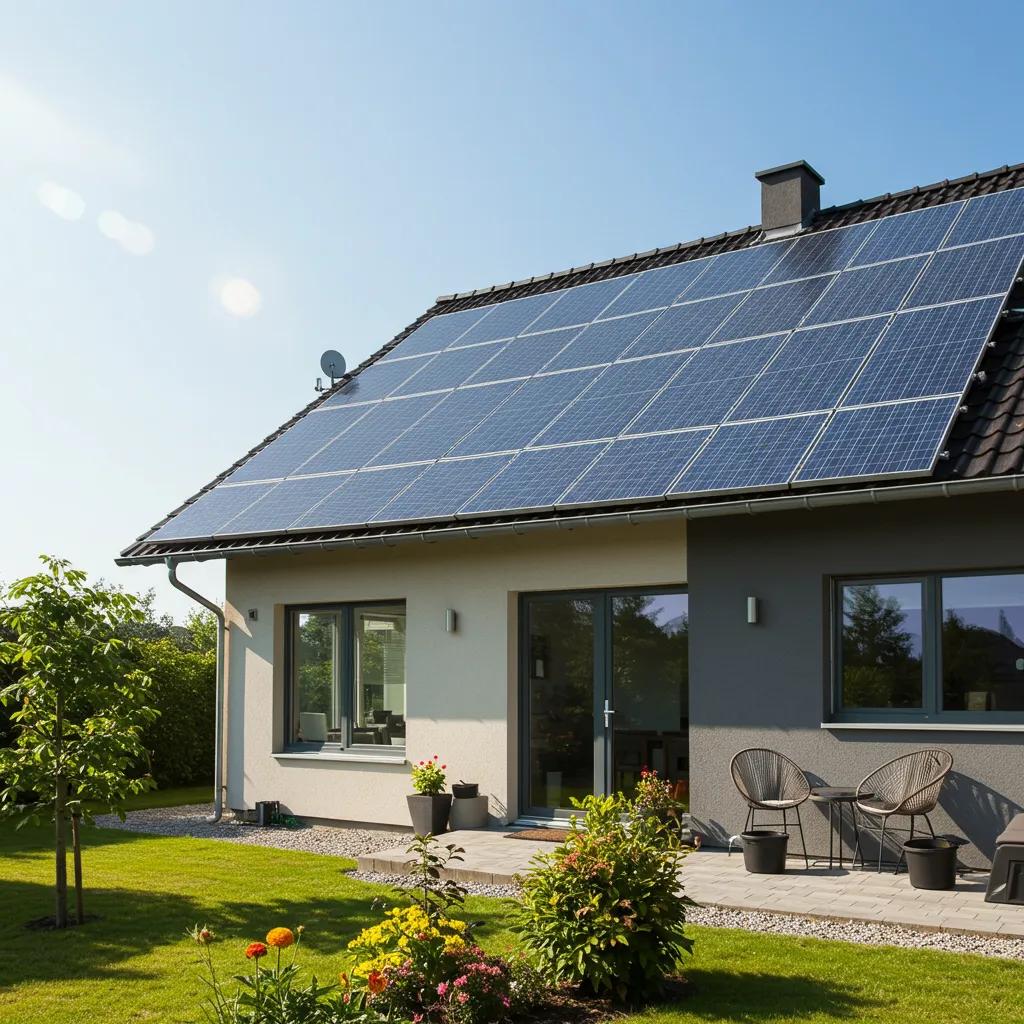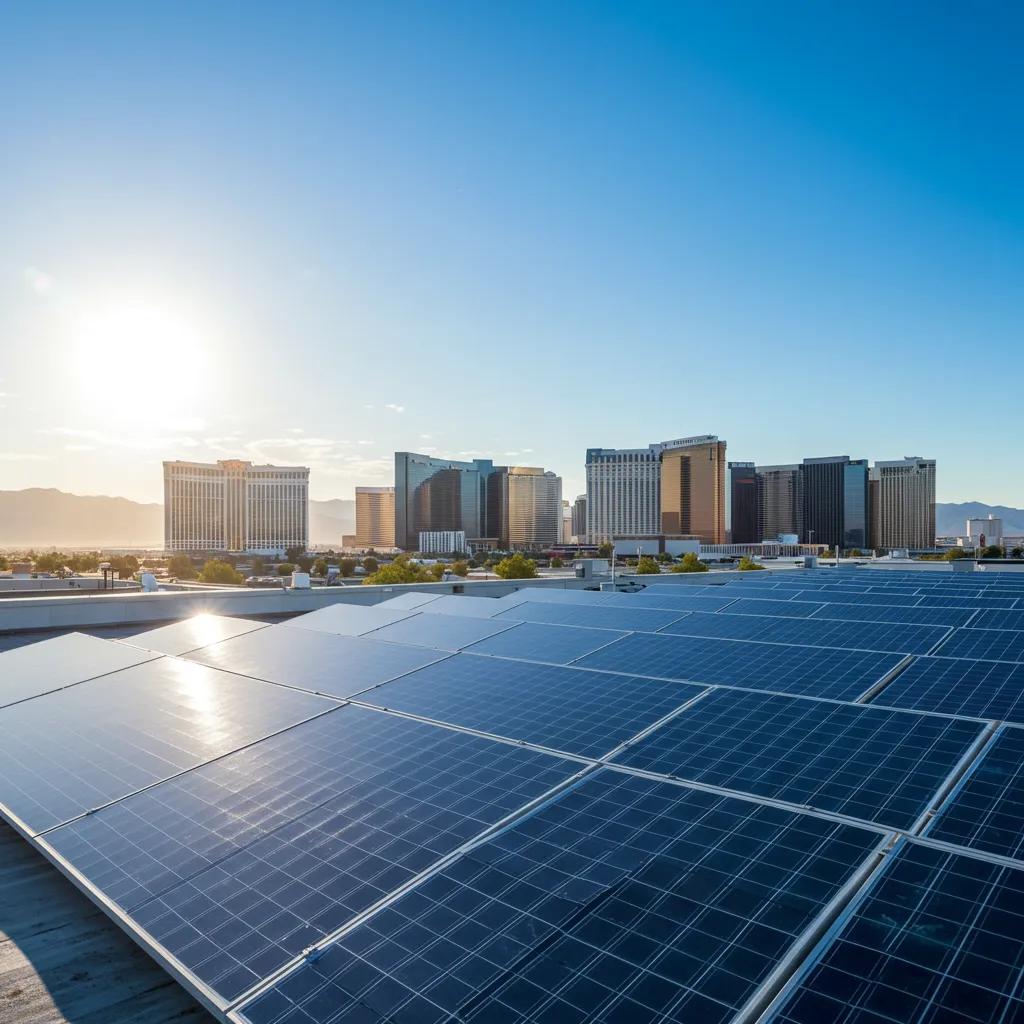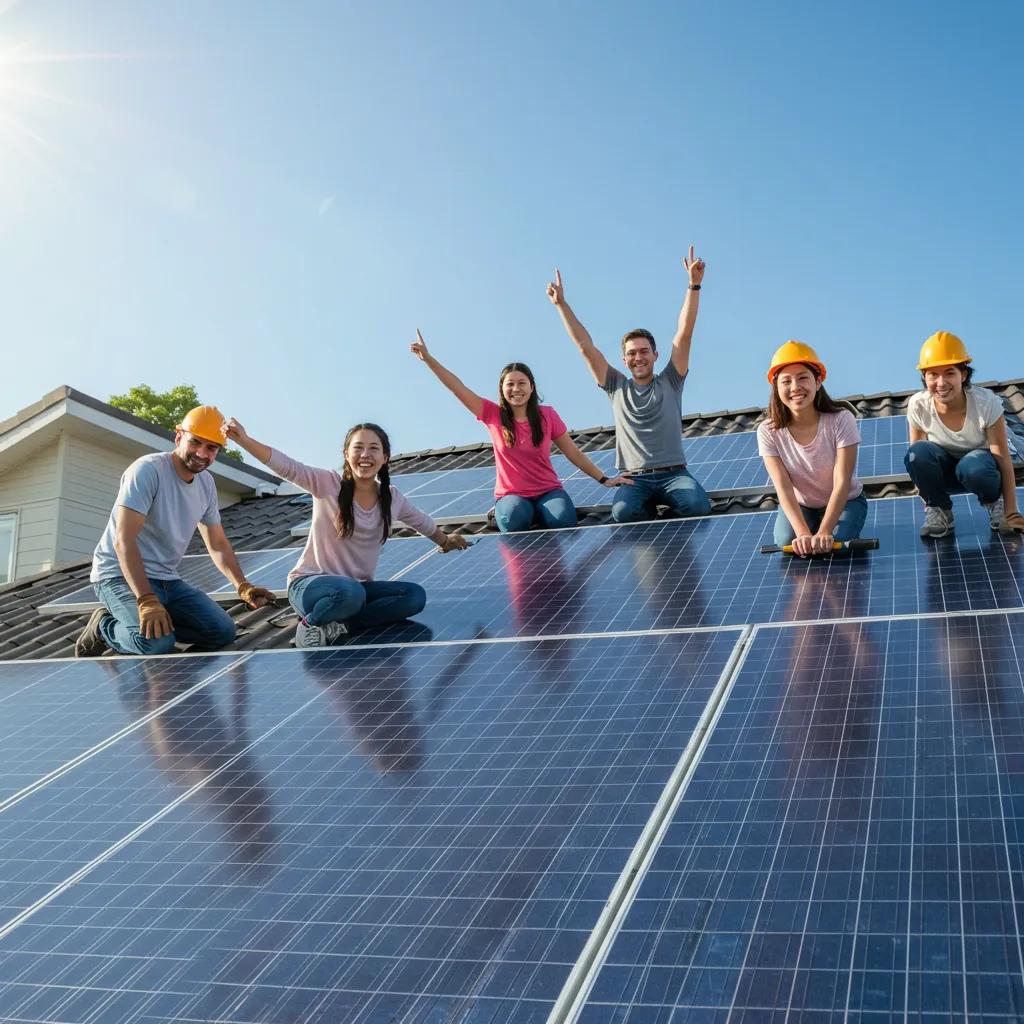Solar PanelEfficiency Ratings Explained: Understanding, Calculating, and Choosing High-Performance Solar Panels
Understanding solar panelefficiency—the percentage of sunlight a photovoltaic module converts into usable electricity—is key to predicting your energy yield and return on investment. This guide breaks down what efficiency ratings truly mean, how they’re calculated under various test conditions, and why factors like celltechnology, temperature coefficient, and degradation rates are especially important for homes and businesses in the Las Vegas climate. You’ll learn practical calculation methods, compare technologies side-by-side, and discover a decision framework that balances roof space, cost, and long-term performance. We also cover localized factors like high irradiance and heat, outline maintenance and monitoring practices to preserve efficiency, and review near-term technology trends through 2025 and beyond. Throughout, you’ll find integrated keywords like solar panelefficiency ratings, STC vs NOCT, TOPCon efficiency, and temperature coefficient solar panels, helping you make informed PV decisions.
What Is Solar PanelEfficiency and How Is It Calculated?
Solar panelefficiency is the ratio of electrical power output to the solar power hitting the panel’s surface, expressed as a percentage. It works by converting photons into electrons via photovoltaic cells, determining how much of the available sunlight becomes usable electricity. This metric matters because higher efficiency means you need less roof space for a given power output, leading to smaller system footprints or greater total energy generation. Installers and designers use multiple metrics—Standard Test Conditions (STC) for lab ratings and Nominal Operating CellTemperature (NOCT) for realistic field estimates—to size systems and forecast production. Understanding these measures helps you compare modules beyond just their wattage and make smarter decisions for your climate and roof constraints.
What Does Solar PanelEfficiency Mean for Energy Output?
Solar panelefficiency directly translates into energy output by defining how many watts a module will produce per square meter under specific irradiance levels, which then converts into kilowatt-hours (kWh) over time. For instance, a 400W module rated at 22% under STC will have a certain area-based output. After accounting for NOCT adjustments and site losses, it will deliver a different real-world kWh per year. This relationship allows you to estimate how many panels you need for your target annual production and to compare modules when roof space is limited. Real-world output is typically lower than STC numbers because factors like temperature, soiling, and wiring losses reduce effective energy production, so designers use derating factors to provide conservative yield estimates.
How Is Solar PanelEfficiency Calculated Using STC and NOCT?
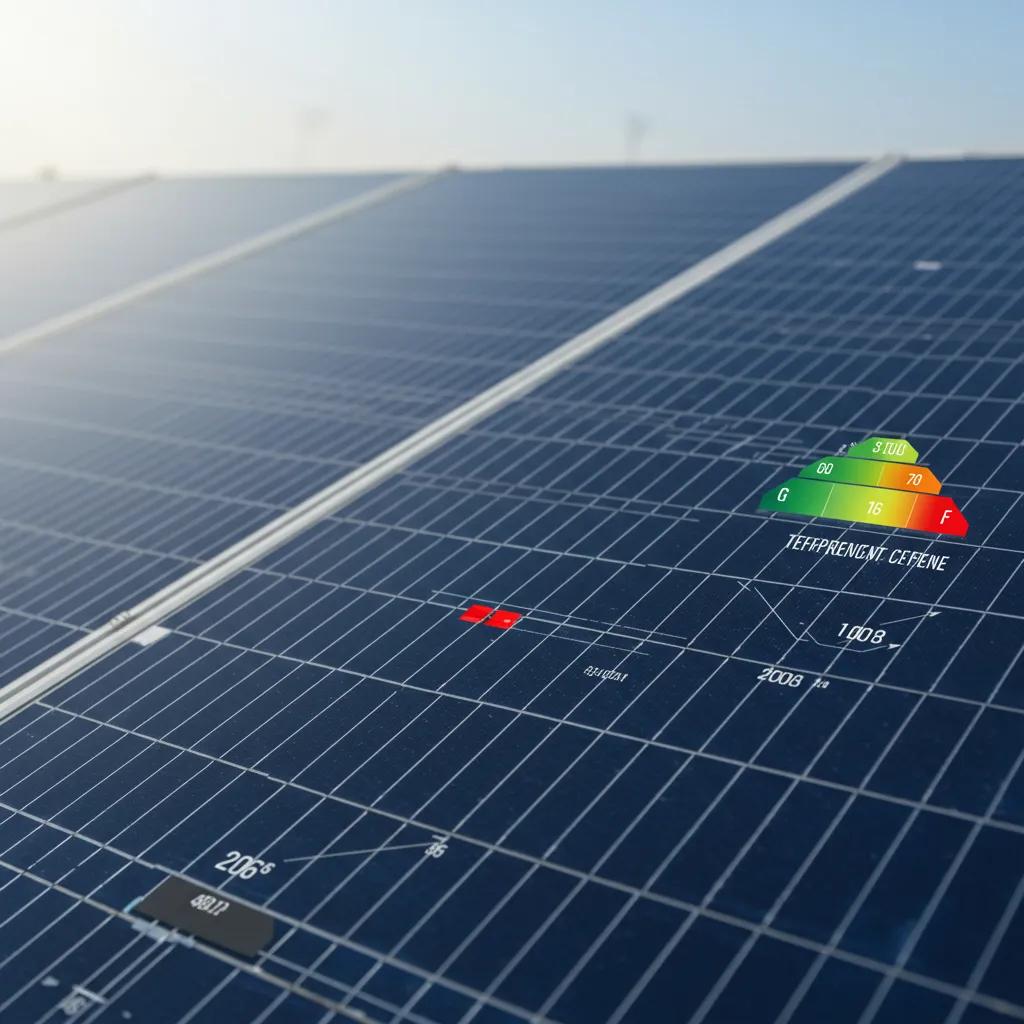
STC (Standard Test Conditions) measures module performance under fixed laboratory conditions: 1,000 W/m² irradiance, 25°C celltemperature, and AM1.5 spectrum. This provides a consistent benchmark for comparing modules. NOCT (Nominal Operating CellTemperature) models more realistic operating conditions, including lower irradiance and higher cell temperatures, so NOCT-based power better approximates expected field output. The formula under STC is: Efficiency (%) = (Module rated power in watts) / (Module area in m² × 1,000 W/m²) × 100. Using NOCT adjustments applies a temperature coefficient and different irradiance assumptions, producing an output figure closer to what you’d expect on a roof in warm climates.
This table clarifies how lab and field metrics relate and why both STC and NOCT matter when estimating your annual energy yield. Installers typically present both figures to give you a realistic production range. Understanding these measures enables better system sizing, yields more accurate payback projections, and helps you compare modules beyond the headline wattage.
What Is the Role of Wattage and Temperature Coefficient in Efficiency?
Wattage (W) is the module’s rated power output under STC and differs from efficiency (%) because wattage also depends on panel area; higher wattage can come from a larger area or higher conversion efficiency. The temperature coefficient quantifies how module output declines for each degree Celsius above the reference 25°C. Modules with lower (less negative) coefficients perform better in heat because they lose less power at high cell temperatures. In hot climates like Las Vegas, a modest difference in temperature coefficient (e.g., −0.25%/°C vs. −0.35%/°C) can translate into several percent of real-world annual energy production, which compounds over the system’s lifetime. Considering both wattage and temperature coefficient helps you select modules that maximize your yearly yield under local peak temperatures.
How Does Degradation Rate Affect Long-Term Efficiency?
Degradation rate is the annual percentage loss in module output and directly reduces your lifetime energy yield and ROI, making it an essential parameter when forecasting long-term savings. A typical modern module may degrade around 0.4–0.8% per year, depending on technology and quality. Over 25 years, even a 0.5% annual degradation compounds to a material reduction in cumulative kWh. Manufacturers’ performance warranties often promise a guaranteed minimum—commonly 80–85% of original output after 25 years—which influences your expected lifetime value. When modeling ROI, installers include degradation in energy yield forecasts and use warranty terms to compare manufacturers; lower degradation rates improve your long-term cash flow and system value.
For owners who want help with accurate efficiency calculations and system sizing, Vegas Solar, LLC performs Solar Energy Consultation (Service) that includes efficiency modeling and tailored recommendations, followed by options such as installation of durable, high-efficiencysolar panels for systems that match projected energy needs. This local consultation pairs technical metrics like STC, NOCT, temperature coefficients, and degradation forecasts with site-specific data to produce realistic yield and payback estimates.
Which Types of Solar Panels Have the Best Efficiency Ratings?
Different panel technologies vary in module efficiency, durability, and cost. Selecting the right type balances your space constraints, budget, and expected lifetime performance. Monocrystalline cells typically lead in efficiency and space-savings, while polycrystalline has historically offered lower cost at reduced efficiency. Emerging N-type technologies such as TOPCon and HJT push commercial efficiencies higher and improve degradation rates, whereas perovskite tandem cells promise significant future gains but remain in the commercialization transition. Comparing these options side-by-side helps you select a technology that fits both your roof constraints and long-term value objectives.
What Is the Efficiency Range of Monocrystalline Solar Panels?
Monocrystalline solar panels generally achieve the highest commercial efficiencies in 2025, with common module ranges around 21–25%, depending on cell type and manufacturing generation. These modules use single-crystalsilicon cells that offer superior electron mobility and denser packing, producing more watts per square meter—an advantage for space-limited rooftops. Higher-efficiency monocrystalline panels often command a price premium but can reduce the total number of panels needed and lower balance-of-system costs for limited roof areas. For many residential installations in Las Vegas, premium monocrystalline modules are compelling when roof area is constrained and maximizing per-roof-kW is a priority.
How Do Polycrystalline Solar Panels Compare in Efficiency and Cost?
Polycrystalline panels typically fall below monocrystalline in efficiency, with module ranges commonly in the high teens to low twenties percent, making them less space-efficient but often more affordable per watt. For sites with ample roof space or ground-mount options, polycrystalline can reduce upfront module costs while delivering acceptable lifetime yield when paired with appropriate inverter and mounting choices. Durability and warranty terms vary by manufacturer, so cost savings should be weighed against potential differences in degradation and long-term performance. In cases where roof area is not limiting and initial budget is the primary driver, polycrystalline remains a practical option.
What Are TOPCon and HJT Solar Panels and Their Efficiency Benefits?
TOPCon (Tunnel Oxide Passivated Contact) and HJT (HeterojunctionTechnology) are advanced N-type siliconcell technologies that improve carrier collection and reduce recombination losses, delivering higher commercial efficiencies and improved long-term stability. In 2025, both TOPCon and HJT modules are increasingly available with module efficiencies often exceeding standard P-type monocrystalline products and offering lower degradation rates. The benefits include better high-temperature performance and reduced degradation, which is meaningful in hot climates like Las Vegas where long-term yield matters. The main trade-off is higher module cost and, for HJT specifically, sometimes higher manufacturing complexity that can affect availability and pricing.
What Is the Future Potential of Perovskite Solar Cells?
Perovskite-silicon tandem cells demonstrate strong lab results with record efficiencies substantially higher than single-junction silicon, and they indicate a promising route toward pushing module efficiencies into the high 20s or 30% range. However, perovskite commercialization faces stability, scaling, and manufacturing hurdles before residential modules become widely available. These challenges mean practical adoption timelines likely span several years. For buyers today, perovskite tandem promise informs long-term planning but does not yet displace proven silicon-based options. Keeping an eye on certification and field reliability will be key as these technologies move toward market readiness.
How to Choose the Right Panel Type for Your Las Vegas Property?
Selecting the right panel type requires matching your roof space, budget, performance expectations, and local climate impacts—especially temperature coefficient and irradiance. Start with a checklist of your constraints and goals: available area, desired annual production, budget, and preference for lower degradation or warranty strength. Then, map those to a panel type that maximizes ROI given Las Vegas conditions. For constrained roofs, prioritize high-efficiency monocrystalline or TOPCon/HJT modules; for cost-sensitive, large-area installs, polycrystalline may be acceptable. Vegas Solar, LLC can source Solar Panels (Product/Service) and design a Solar Panel Configuration designed for optimal power output, combined with Solar PanelInstallation (Service), to tailor a system that fits both your property and performance goals.
What Factors Affect Solar PanelEfficiency in Las Vegas Climate?
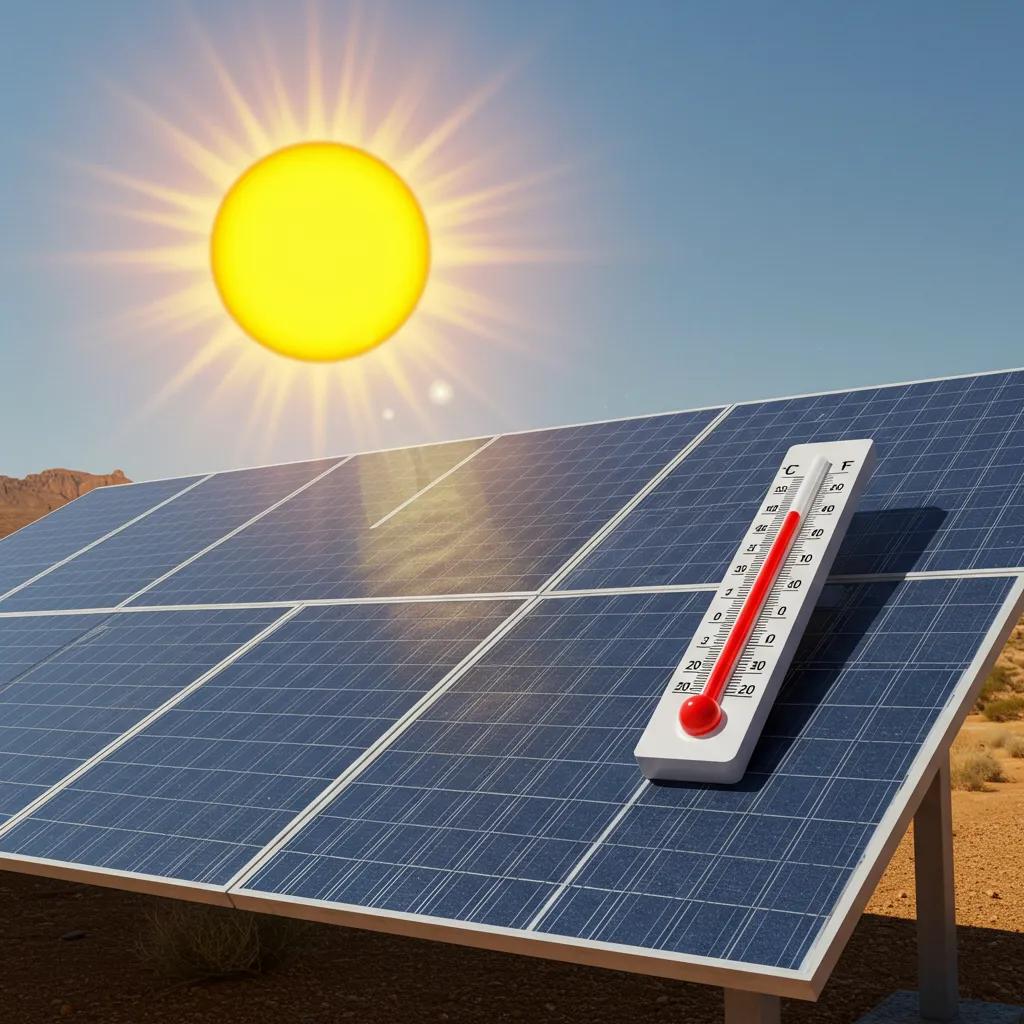
Your local climate exerts a major influence on real-world panel efficiency because factors such as high temperature, intense irradiance, dust/soiling, and shading patterns determine actual energy yield. Las Vegas benefits from very high solar irradiance, which increases potential energy production, but the region’s high daytime temperatures reduce module power via temperature coefficient effects. Installation choices—tilt, orientation, ventilation, and choice of racking—plus maintenance practices like cleaning and monitoring, significantly mitigate losses and preserve long-term efficiency. Considering each factor and applying targeted mitigations is essential for maximizing the net advantage of high irradiance while minimizing heat-related and soiling losses.
How Does High Temperature Impact Solar Panel Performance?
High ambient and cell temperatures reduce module voltage and therefore lower power output according to the module’s temperature coefficient, which typically ranges from roughly −0.2 to −0.4%/°C depending on technology. In Las Vegas peak summer daytime temperatures, cell temperatures can exceed ambient by 20–40°C, producing several percent of output loss compared with STC performance; over a year, this reduces cumulative yield. Mitigation strategies include selecting modules with favorable (less negative) temperature coefficients, mounting panels on racks that allow airflow, and using Solar Ventilation (Service) or raised mounting to lower operating temperatures. Good design and ventilation can reclaim a meaningful portion of temperature-related losses.
Key temperature mitigation actions for high-heat climates:
- Choose low (less negative) temperaturecoefficient modules to reduce heat-related output loss.
- Use ventilated racking and raised mounts to increase airflow and lower cell temperature.
- Consider site layout and tilt to balance midday heat with seasonal production.
Applying these practices reduces temperature-driven losses and supports higher year-round yield, leading naturally into how shading and installation quality further influence performance.
What Is the Effect of Shading and Installation Quality on Efficiency?
Shading—even partial or intermittent—can cause disproportionate power loss because cells in series strings limit total current to the shaded cell. Mismatch losses from soiling or uneven irradiance further reduce output. Installation quality matters: correct tilt, orientation, wiring, and use of module-level power electronics (MLPE) like optimizers or microinverters mitigate shading and mismatch effects, preserving module-level performance. Professional design accounts for roof obstructions, seasonal shading patterns, and incorporates MLPE where appropriate to prevent one shaded panel from dragging down an entire string. Investing in quality installation practices significantly improves real-world performance and justifies the incremental cost through higher sustained yield.
How Does Maintenance Influence Solar PanelEfficiency Over Time?
Regular maintenance—cleaning panels of dust and debris, inspecting for damage, and monitoring output—prevents soiling and faults that otherwise lower energy yield and compound degradation effects. In desert environments, recommended actions include periodic washes, visual inspections after storms, and continuous monitoring systems that flag underperformance for quick diagnostics. Monitoring paired with preventative maintenance reduces downtime and helps maintain warranty coverage by documenting proper system care. Vegas Solar, LLC provides monitoring and maintenance solutions through Solar PanelInstallation (Service) and related support to help preserve efficiency and diagnose repairs promptly.
How Does Las Vegas’ Solar Irradiance Affect Panel Output?
Las Vegas’ high solar irradiance offers a major production advantage because greater incident sunlight increases potential kWh production per installed kW, improving system economics even when temperature reduces module output somewhat. Seasonal and diurnal irradiance patterns still matter for storage and load management planning, influencing system sizing decisions for self-consumption and grid export. High irradiance combined with proper panel selection and ventilation often results in superior annual production compared with cooler regions with less sun. Balancing irradiance benefits with heat mitigation practices is the practical approach for maximizing net annual energy yield in the Las Vegas climate.
How to Choose High EfficiencySolar Panels for Your Home or Business?
Choosing high-efficiency panels requires a structured evaluation of cost, roof space, warranty, and complementary devices like inverters and storage that influence effective system efficiency. Your decision framework should quantify area-per-kW, estimate payback under local electricity rates and incentives, and incorporate degradation and temperature behaviors into lifetime yield models. Practical steps include comparing modules by efficiency and temperature coefficient, calculating the required area for your target kW, and deciding whether premium modules justify a higher upfront cost through a smaller system size or longer-term yield advantages. Using a checklist and modeling scenario comparisons helps you weigh trade-offs clearly.
What Are the Cost Considerations for High Efficiency Panels?
High-efficiency panels usually carry a per-watt premium, but they can reduce total system area and sometimes lower balance-of-system costs by needing fewer racks and less roof space. The net cost per kilowatt-hour depends on module price, BOS, incentives, and projected yield. When evaluating ROI, include installation costs, expected energy production (with degradation), utility rate escalation, and any applicable local incentives to estimate your payback period. A simple example compares two systems sized for the same annual production: higher-efficiency modules can reduce the number of panels and possibly installation complexity, which may offset module price over the system life. Use scenario modeling to decide when premium modules are financially justified.
Typical financial factors to evaluate:
- Module cost per watt versus long-term kWh output.
- Balance of system(BOS) costs such as racking and labor for panel count differences.
- Incentives and tax considerations that affect upfront cost and payback.
These financial considerations lead directly to how roof space shapes your panel selection decision.
How Does Roof Space Influence Panel Selection and Efficiency?
Roof space constrains the achievable system size and raises the value of higher-efficiency modules when area is limited, because more efficient panels deliver more watts per square meter and require fewer modules to meet your energy goals. Calculate your required panel area by dividing your desired array power by the expected per-module wattage and factor in spacing and tilt; this yields a practical area requirement for selection. When roofs are constrained, prioritize monocrystalline or TOPCon/HJT modules to maximize kW per roof area. When ample space exists, lower-cost polycrystalline or larger arrays may be more economical. Alternative mounting options—carports or ground-mount systems—provide flexibility when roof capacity is insufficient.
What Warranty and Durability Should You Expect from Efficient Panels?
Efficient panels typically come with both product warranties and performance warranties. Industry norms for performance warranties often guarantee around 80–85% of original output after 25 years, while product warranties cover workmanship for variable periods. When assessing warranties, check for linear degradation guarantees, coverage exclusions, and the manufacturer’s track record, since warranty terms influence your long-term yield confidence and resale value. Installer warranties for workmanship and system components add a layer of protection, so evaluate both manufacturer and installer guarantees when choosing panels. Durable module packaging, robust frames, and quality junction boxes further reduce the risk of early failures.
How Can Energy-Saving Devices Complement Solar PanelEfficiency?
Energy-saving devices and system-level technologies increase the effective efficiency of a solarinstallation by reducing demand, optimizing self-consumption, and smoothing load profiles, thereby maximizing the value of generated energy. Smart inverters, energy-efficient appliances, demand-response strategies, and battery storage allow you to shift consumption to daylight hours and increase on-site utilization of PV production. For example, using smart inverters and battery energy storage systems (BESS) with proper control strategies can elevate effective self-consumption and reduce exported surplus at low buyback rates. Integrating these devices with monitoring enhances system control and long-term performance.
Ways energy-saving devices improve system effectiveness:
- Smart inverters and monitoring to optimize output and manage export.
- Battery storage to shift peak production to peak consumption periods.
- Energy-efficient appliances and load-shifting to lower required array size.
These complementary measures, when combined with appropriate panel selection, strengthen overall system economics and resilience.
What Are the Latest Trends and Future Outlook for Solar PanelEfficiency?
In 2025, the module landscape continues to see incremental efficiency gains from N-type TOPCon and HJT technologies, broader deployment of module-level electronics, and stronger integration with storage and smart inverters to increase system-level effective efficiency. Average commercial module efficiencies are in the low 20% range with premium products exceeding that, and manufacturers are improving degradation and temperature performance. Research on perovskite tandems and manufacturing scale improvements suggests more rapid efficiency gains in the coming years, while expanded global PV capacity drives R&D investment and price competition that improves module availability and lowers costs. You should weigh near-term module advancements against system readiness and proven warranties.
What Efficiency Improvements Are Expected in 2025 and Beyond?
Recent industry momentum shows incremental module efficiency improvements through wider adoption of N-type architectures and improved cell processing, pushing many commercial modules into the 22–24% range in 2025. Near-term gains are expected to come from production-scale TOPCon and HJT processes, reduced recombination losses, and better passivation techniques. These advances also often improve degradation and temperature behavior. For homeowners and businesses, the implication is that waiting for marginally higher efficiency may not always be optimal—balance between current generation performance, warranty, and price is key for decisions within a short horizon.
How Are Smart Inverters and Energy Storage Enhancing Efficiency?
Smart inverters and battery energy storage systems enhance system-level efficiency by managing power flows, performing maximum power point tracking (MPPT), enabling reactive power support, and facilitating higher self-consumption of solar production. These technologies reduce losses from suboptimal export and enable load-shifting so generated energy is used when it has the highest value, effectively increasing the utility of each kWh produced. Integrated monitoring and AI-driven controls further optimize daily and seasonal operation to reduce curtailment and respond to grid signals, improving both resilience and economic returns.
What Role Do Perovskite Tandem Cells Play in Future Efficiency Gains?
Perovskite tandem cells pair perovskite absorbers with silicon to capture a broader solar spectrum, offering laboratory efficiencies that exceed single-junction silicon and pointing to the potential for modules in the high-20s to low-30s percent efficiency range. Commercial adoption hinges on solving stability and scaling challenges, which are the main barriers to residential availability in the near term. For system planners, perovskite tandems represent a strategic watch area: as they mature, they may change the calculus for high-efficiency, space-limited installations.
How Is the Global Growth of Solar PV Capacity Influencing Efficiency Standards?
Growing global PV deployment accelerates R&D investment, manufacturing scale, and competition among module makers, which collectively push efficiency improvements and cost reductions in the supply chain. As production scales and new cell architectures achieve manufacturing maturity, higher-efficiency modules become more accessible and cost-competitive, altering the options available to residential and commercial buyers. This dynamic creates downward pressure on module prices while also enabling greater variety in high-performance products, benefiting system designers and end customers in local markets.
What Are the Most Common Questions About Solar PanelEfficiency?
This FAQ-style section answers common People-Also-Ask questions concisely and practically, offering quick reference guidance for homeowners and businesses comparing modules and planning installation. The answers focus on actionable figures and rational trade-offs—what constitutes good efficiency in 2025, how degradation shapes ROI, and practical steps to maximize on-site performance. Below are targeted, snippet-friendly responses that synthesize the key points covered earlier and point toward next steps for readers evaluating or planning solar projects.
What Is a Good Efficiency Rating for Residential Solar Panels?
A good residential module efficiency in 2025 typically falls in the 21–23% range for mainstream high-performance modules, while premium TOPCon or HJT products can exceed 23–25%, depending on the manufacturer and model. Target higher-efficiency modules when roof area is limited or when minimizing panel count is a priority; otherwise, weigh the premium cost against BOS and installation savings. The ideal choice depends on the specific trade-off between your upfront budget, available roof area, and desired lifetime yield.
Do Solar Panels Lose Efficiency Over Time?
Yes—solar panels experience gradual degradation, typically around 0.4–0.8% per year for modern modules, which compounds over the system lifetime and reduces cumulative kWh output. Manufacturers provide performance warranties that specify guaranteed output levels after periods such as 10 or 25 years, which should be factored into your ROI calculations. Regular maintenance, proper installation, and selecting low-degradation technologies help minimize the impact on long-term efficiency.
How Does Solar PanelEfficiency Affect Energy Savings and ROI?
Higher-efficiency modules can reduce required system area and sometimes lower BOS costs, which improves energy savings per roof area and can shorten payback periods when space is constrained. However, premium modules may have higher upfront costs that extend payback if additional yield does not offset the price premium. Modeling lifetime kWh production, including degradation and local electricity rates, clarifies the ROI. For many installations, the best approach balances efficiency with total installed cost and expected lifetime performance.
How Can I Maximize Solar PanelEfficiency in My Home?
Maximizing efficiency requires a combination of correct panel selection, optimal tilt and orientation, mitigation of shading, routine cleaning, and use of monitoring and MLPE to reduce mismatch losses and quickly identify issues. Implement a maintenance schedule for desert environments, consider ventilated mounts to reduce operating temperature, and use smart inverters and energy management to increase effective self-consumption. Monitoring systems empower proactive repairs and performance tuning, preserving efficiency across the system lifetime.
- Select modules with favorable temperaturecoefficients and low degradation.
- Design for minimal shadingand optimal tilt/orientation for the site.
- Schedule regular cleaning and inspections appropriate for desert conditions.
- Use MLPE (optimizers/microinverters) and monitoring to mitigate mismatch and detect faults.
- Consider energystorage and load-shifting to maximize on-site utilization.
These steps form a practical checklist for homeowners to protect and enhance real-world system efficiency and are directly actionable for local installations.
What Are the Differences Between Efficiency Ratings and Performance Ratings?
Efficiency ratings express the laboratory-measured conversion percentage of sunlight to electricity under STC, while performance ratings and metrics like Performance Ratio (PR) describe real-world energy yield relative to theoretical production, accounting for system losses. Two panels with the same STC efficiency can perform differently in the field due to differences in temperature coefficient, degradation rate, spectral response, and soiling resistance. Installers therefore use PR and modeled yield estimates to forecast actual energy production. Accurate system design evaluates both lab efficiency and expected field performance metrics when estimating annual kWh and ROI.
For a personalized evaluation of system efficiency and a custom proposal tailored to your property and goals, consider scheduling a Free Consultation with Vegas Solar, LLC. Their Solar Energy Consultation (Service) includes on-site assessment, efficiency calculations, and options for installation of durable, high-efficiencysolar panels if you decide to proceed. This final step helps translate technical metrics into an actionable plan that fits both your budget and performance objectives.
Frequently Asked Questions
What are the main factors influencing solar panelefficiency in different climates?
Solar panelefficiency is significantly influenced by climate factors such as temperature, irradiance, and environmental conditions. In hotter climates, like Las Vegas, high temperatures can reduce the voltage output of solar panels, leading to lower efficiency. Conversely, high solar irradiance increases potential energy production. Additionally, factors like dust accumulation and shading can further impact efficiency. Therefore, understanding local climate conditions is crucial for selecting the right solartechnology and optimizing installation for maximum energy yield.
How do I maintain my solar panels to ensure optimal efficiency?
Regular maintenance is essential for preserving solar panelefficiency. This includes cleaning panels to remove dust and debris, which can block sunlight and reduce output. Inspecting for physical damage and monitoring performance can help identify issues early. In desert environments, periodic washes and visual inspections after storms are recommended. Implementing a monitoring system can also alert you to underperformance, allowing for timely maintenance actions that keep your solar system operating at peak efficiency.
What is the impact of installation quality on solar panel performance?
The quality of solar panelinstallation plays a critical role in overall system performance. Proper tilt, orientation, and wiring are essential to maximize energy capture and minimize losses. Additionally, using module-level power electronics (MLPE) like optimizers or microinverters can help mitigate shading effects and improve energy output. A professional installation that considers site-specific factors, such as shading patterns and roof obstructions, can significantly enhance the efficiency and longevity of the solar system.
How do energy-saving devices enhance the efficiency of solar panel systems?
Energy-saving devices, such as smart inverters and battery storage systems, can significantly enhance the efficiency of solar panel installations. They optimize energy usage by managing power flows and enabling load-shifting, which allows homeowners to use solar energy during peak production times. This increases self-consumption and reduces reliance on grid power. Additionally, integrating energy-efficient appliances and demand-response strategies can lower overall energydemand, further maximizing the value of the energy generated by solar panels.
What are the expected trends in solar panelefficiency for the coming years?
In the coming years, solar panelefficiency is expected to improve due to advancements in technology, particularly with N-type architectures like TOPCon and HJT. These technologies are anticipated to push commercial efficiencies into the 22-24% range by 2025. Additionally, ongoing research into perovskite tandem cells may lead to even higher efficiencies in the future. As the solar market grows, increased competition and R&D investment will likely drive down costs while enhancing performance, making solar energy more accessible and efficient.
How can I assess the return on investment (ROI) for solar panels?
To assess the ROI for solar panels, consider factors such as installation costs, expected energy production, local electricity rates, and available incentives. Calculate the payback period by estimating how long it will take for energy savings to cover the initial investment. Additionally, factor in the degradation rate of the panels, as this will affect long-term energy yield. Using scenario modeling can help clarify the financial trade-offs between different panel types and configurations, ensuring a well-informed investment decision.

